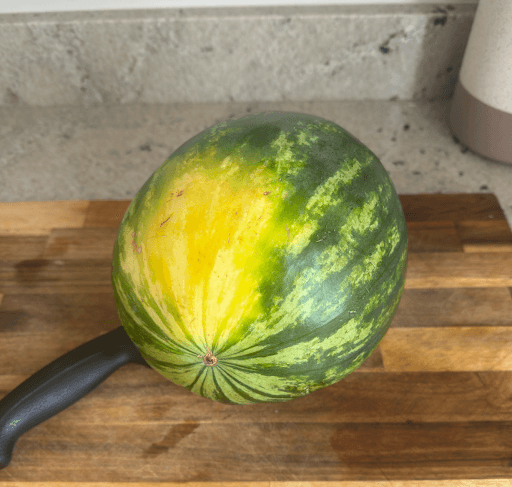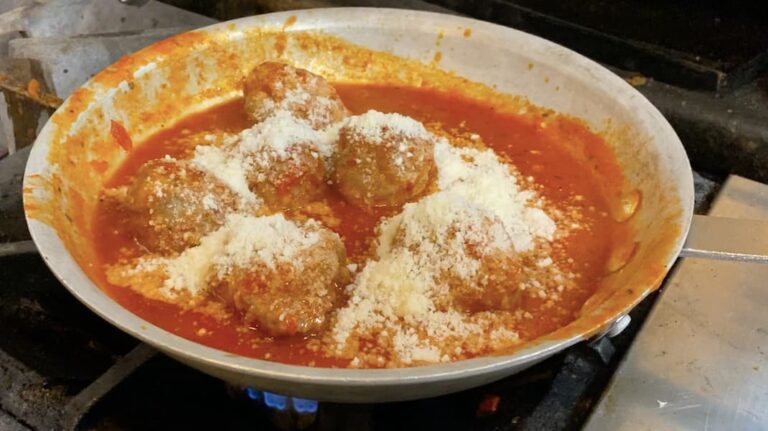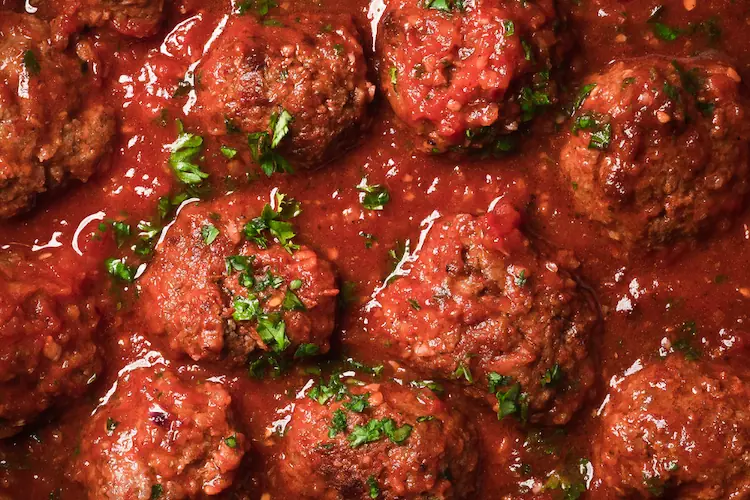On hot summer days, I eat a lot of fresh watermelon. Nothing beats the heat better than a juicy slice of watermelon. But have you ever wondered how to tell if watermelon is bad?
Summer is when watermelon is at its best—juicy, sweet, and refreshing. Whether I’m picking one up from the grocery store or the farmer’s market, it’s always a quintessential part of the season.
Knowing how to tell if watermelon is bad is essential to avoid disappointment. Watermelon is an excellent choice for a healthy summertime treat. It’s a nutrient-dense fruit, low-calorie, and hydrating. A one-cup serving of raw, diced watermelon contains just 46 calories and about 0.9 grams of protein.
But sometimes, I’ve found myself opening a container of cut melon and thinking, “Is overripe watermelon safe to eat?” Or worse, noticing signs of spoilage too late.
Here’s a complete guide on how to tell if watermelon is bad, including tips for identifying spoilage, proper storage methods for both whole and cut watermelon, what to do with overripe watermelon, and how to safely enjoy this summer fruit at its best.

How to Pick the Perfect Watermelon at the Store
Before worrying about spoilage, let’s talk about selecting the perfect watermelon. Here are the key indicators of a ripe, juicy melon:
- Uniform Shape: Avoid melons with irregular bumps or dents, as they may ripen unevenly.
- Field Spot: A creamy yellow spot on the underside (not white or green) means it ripened naturally in the field.
- Surface Dullness: A shiny rind indicates underripeness, while a dull finish suggests it’s ready to eat.
- Tendril Check: Look for a dried, brown tendril near the stem—it’s a good sign of ripeness.
- Weight Test: A ripe watermelon feels heavy for its size because of its high water content.
How to Tell If Watermelon Is Bad
Here are the top signs to help you spot a spoiled watermelon:
Signs a Whole Watermelon Has Gone Bad
- Rind Issues: A firm rind is a sign of freshness. If the rind feels mushy, soft, or has large dents, the melon is likely spoiled.
- Discoloration: A healthy watermelon will have a creamy yellow field spot. Brown, dark patches, or mold indicate spoilage.
- Weight: A ripe watermelon should feel heavy for its size. If it feels unusually light, it may be overripe or dry.
- Sound Test: When tapped, a fresh watermelon makes a hollow sound. A dull thud signals that it’s gone bad.
Signs a Cut Watermelon Has Gone Bad
- Color: Fresh watermelon flesh should be vibrant red or deep pink. If you see dark spots, brown patches, or a dull hue, it’s time to toss it.
- Texture: Spoiled watermelon often turns mushy, slimy, or mealy. Crisp, juicy flesh is a sign of freshness.
- Smell: A sour, fermented, or unpleasant smell is a red flag for spoilage.
- Excess Moisture: If you see pooling liquid around the flesh, it’s likely caused by bacterial growth.
How Long Does Watermelon Last?
- Uncut Watermelon: Stays fresh for 7–10 days at room temperature or up to 2 weeks if stored in a cool, dark place.
- Cut Watermelon: Lasts 3–5 days when stored in an airtight container in the refrigerator.
How to Store Watermelon Properly
Storing Whole Watermelon
- Keep uncut watermelons at room temperature and out of direct sunlight.
- For longer storage, place them in a cool, dark place like a pantry or cellar.
Storing Cut Watermelon
- Wrap Method: Wrap larger pieces tightly with plastic wrap to preserve moisture.
- Airtight Container: Store smaller pieces or cubes in a shallow, airtight container to prevent flavor loss.
- Paper Towel Trick: Line a plate with paper towels to absorb excess moisture, keeping the flesh crisp.
How to Tell If Watermelon Is Bad Without Cutting It
Sometimes, you can spot a bad watermelon before slicing it open:
-
- Rind Texture: Soft, mushy areas or visible mold.
- Unusual Smell: A fermented odor near the stem.
- Surface Issues: White or dark patches instead of a yellow field spot.
Is Overripe Watermelon Safe to Eat?
Overripe watermelon may lose its sweet flavor and crisp texture but is generally safe to eat as long as:
- There’s no sour smell, slimy flesh, or mold.
- The texture isn’t excessively mushy or mealy.
Tip: If you’re unsure, it’s better to discard it to avoid any risk.
Nutritional Risks of Eating Spoiled Watermelon
Eating spoiled watermelon can lead to:
- Foodborne Illness: Bacterial contamination like Salmonella or E. coli.
- Symptoms: Nausea, vomiting, diarrhea, and stomach cramps.
When in doubt, throw it out.

How to Prevent Watermelon From Going Bad Quickly
- Store whole watermelons in a cool, dark place.
- Always use clean knives to cut watermelon.
- Wrap cut ends tightly with plastic wrap or beeswax wraps.
- Refrigerate cut watermelon immediately.
What to Do with Overripe Watermelon
Don’t toss it just yet! Here are creative ways to repurpose slightly overripe watermelon:
- Watermelon Jam: Simmer blended watermelon with sugar and lemon juice to make a sweet spread.
- Frozen Treats: Blend and freeze into popsicles or sorbet.
- Watermelon Gazpacho: A refreshing twist on traditional gazpacho soup.
- Cocktails and Mocktails: Use overripe watermelon as the base for summer drinks.
Signs of Spoilage in Other Melons
For broader melon lovers, here’s how to spot spoilage in cantaloupes and honeydews:
- Honeydew: Discoloration, wrinkled skin, or a mushy texture.
- Cantaloupe: Soft spots, fermented smell, and dark orange flesh.
FAQs: How to Tell If Watermelon Is Bad
Can I eat watermelon with white seeds?
Yes! White seeds are immature black seeds and are perfectly safe to eat.
Why is my watermelon foaming?
Foaming is a sign of bacterial fermentation. It’s best to discard it immediately.
Can I freeze watermelon?
Absolutely! Cut it into cubes, freeze on a tray, then store in freezer bags for smoothies or sorbets.
How long does watermelon last in the fridge?
Cut watermelon lasts 3–5 days in an airtight container.
What happens if I eat bad watermelon?
Consuming spoiled watermelon can lead to food poisoning symptoms like nausea, vomiting, and diarrhea.
My Favorite Watermelon Recipes
Now that we’ve gotten to the bottom of this melon matter, let’s talk about the delicious ways you can enjoy it. Try making one of these next time you find yourself with a bunch of ripe melons.
- Watermelon and Feta Salad: I love how simple this is. Combine watermelon chunks with feta cheese, a drizzle of olive oil, fresh mint, and a sprinkle of black pepper for a super flavorful side dish. Add pistachios if you want a little crunch.
- Watermelon Sorbet: On a low-calorie diet? This is a healthy and delicious alternative to traditional ice cream. Simply blend frozen watermelon chunks, a squeeze of fresh lime juice, and a touch of honey for a sweet and refreshing sorbet.
- Watermelon Salsa: Have you had enough of summer tomatoes? Watermelons offer a vibrant and refreshing take on traditional salsa. Combine cubed watermelon with chopped red onion, jalapeno (if you like a kick), lime juice, fresh cilantro, and a pinch of salt. Enjoy it with chips, grilled fish, or tacos.
- Frozen Watermelon Popsicles: Puree the edible part of the fruit with honey or lime juice, pour the mixture into popsicle molds, and freeze for a delightful summertime snack.
- Fruit-Infused Water: Infuse your water with fresh watermelon chunks to add a touch of summer. Combine watermelon with other fruits like cucumber, orange, or berries for a refreshing and hydrating drink.
Enjoy Watermelon the Right Way
Knowing how to tell if watermelon is bad ensures you enjoy every bite of this summer favorite without disappointment. By checking the rind, weight, texture, and smell, you can confidently avoid spoiled melons.
Have tips of your own or favorite watermelon recipes? Drop them in the comments below! And if you’re looking for more fruit-focused recipes, be sure to explore our delicious lineup here on Mortadella Head.










